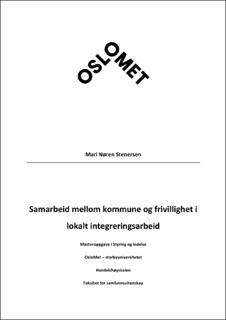| dc.contributor.advisor | Høydal, Øyunn Syrstad | |
| dc.contributor.author | Stenersen, Mari Nøren | |
| dc.date.accessioned | 2023-08-28T11:55:49Z | |
| dc.date.available | 2023-08-28T11:55:49Z | |
| dc.date.issued | 2023 | |
| dc.identifier.uri | https://hdl.handle.net/11250/3086004 | |
| dc.description.abstract | Det rettes mye oppmerksomhet mot behovet for nye og innovative måter å organisere offentlig sektor på. Dette kan blant annet knyttes til urolighet rundt den norske velferdsmodellens begrensninger i møte med sammensatte utfordringer innen områder som klima, eldreomsorg, økende sosiale forskjeller og integrering. En av løsningene som utpekes er mer involvering og samarbeid med frivillig sektor. I forbindelse med den såkalte «flyktningkrisen» i 2015, ble samarbeid mellom offentlige og frivillige aktørene innen integreringsfeltet satt på dagsorden, og dette er igjen aktualisert gjennom krigen i Ukraina. Nyere forskning har avdekket et behov for mer kunnskap om barrierer og suksessfaktorer for samarbeid mellom offentlige og frivillige aktører, og spesielt behovet for økt kunnskap om samhandling og samarbeid på integreringsfeltet (Eimhjellen et al., 2021, s. 72).
Formålet med denne studien er få kunnskap om hva ansatte i kommuner opplever som drivere og barrierer for samarbeid med frivillighet i lokalt integreringsarbeid. Studien har vært spesielt opptatt av å utforske dette i lys av lokal kontekst gjennom kommunenes organisering, samt hvordan erfaringer fra tidligere kriser har påvirket samarbeid. Innretningen på studien er kvalitativt forskningsdesign, og det empiriske grunnlaget er dybdeintervjuer med kommuneansatte i syv norske kommuner. Det teoretiske grunnlaget støtter seg på litteraturen om samarbeid og samstyring (governance), og spesielt Chris Ansell og Alison Gash (2008) sin modell for «collaborative governance».
Studiens funn peker på fire faktorer som særlig betydningfulle drivere og/eller barrierer for samarbeid mellom kommune og frivillighet i integrering. Disse er forankring, ressurser, rolleforståelse, og erfaring og kompetanse. Overordnet viser funnene at de ansattes opplevelse av samarbeidet ikke kan forklares på bakgrunn av enkeltfaktorer, og hvorvidt de oppleves som driver eller barriere for samarbeid avhenger av lokal kontekst. Det er funn som viser til at forankring, gjennom for eksempel en sterk frivillighetspolitikk, er en driver for samarbeid men ikke en forutsetning for at samarbeid skal skje. Dette viser blant annet til en kultur og tradisjon for samarbeid, som kan ha blitt forsterket gjennom erfaringer fra tidligere kriser. Funn fra denne studien og hvilke implikasjoner de fire faktorene gir med tanke på samarbeid, vil kunne ha en relevans for kommuner i forberedelse og gjennomføring av samarbeid med frivillighet om integrering. | en_US |
| dc.description.abstract | Much attention is paid to the need for new and innovative ways of organizing the public sector. Among other things, this can be linked to uneasiness about the limitations of the Norwegian welfare model in the face of complex challenges such as climate change, elderly care, growing social differences and integration. One of the identified solutions is more involvement and collaboration with the voluntary sector. In connection with the so-called "refugee crisis" in 2015, cooperation between the public sector and volunteers in the field of integration was put on the agenda, and his has again been actualized through the war in Ukraine. Recent research has revealed a need for more knowledge about barriers and success factors for cooperation between the public and voluntary sector, and especially the need for increased knowledge about interaction and cooperation in the field of integration (Eimhjellen et al., 2021, p. 72).
The purpose of this study is to gain knowledge about what employees in municipalities experience as opportunities and limitations for collaboration with volunteers in local integration work. The study has been particularly concerned with local context, through the municipalities organisational structure, as well as how experiences from previous crises have influenced cooperation. The design of the study is a qualitative research design, and the empirical basis is interviews with municipal employees in seven Norwegian municipalities. Theory is based on the literature on collaboration and collaborative governance, and in particular Chris Ansell and Alison Gash's (2008) model for "collaborative governance".
The study's findings point to four factors as particularly significant opportunities and/or limitations to cooperation between the municipality and volunteering in integration. These are anchoring, resources, role sensitivity, and experience and competence. Overall, the findings show that the employees' experience of collaboration cannot be explained on the basis of individual factors, and whether they are perceived as opportunities or limitations to collaboration depends on the local context. There are findings that show that anchoring, through for example a strong policy, is perceived as a strong enhancer for cooperation but not a prerequisite for cooperation to take place. This refers, among other things, to a culture and tradition of cooperation, which may have been strengthened through experiences from previous crises. Findings from this study and the implications of the four factors in terms of cooperation may have relevance for municipalities in the preparation and implementation of cooperation with volunteers in integration work. | en_US |
| dc.language.iso | nob | en_US |
| dc.publisher | OsloMet-Storbyuniversitetet | en_US |
| dc.subject | Integreringsarbeid | en_US |
| dc.subject | Frivillighet | en_US |
| dc.subject | Samstyring | en_US |
| dc.subject | Offentlig sektor | en_US |
| dc.subject | Integrering | en_US |
| dc.title | Samarbeid mellom kommune og frivillighet i lokalt integreringsarbeid | en_US |
| dc.type | Master thesis | en_US |
| dc.description.version | publishedVersion | en_US |
